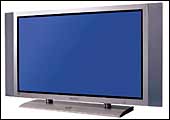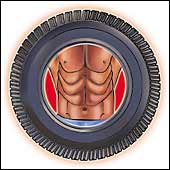|
 Suppose
a rich uncle just left you a decent inheritance, and you really
did not know what to do with the money, might this correspondent
make a small suggestion? Increase the space in your living room.
No fancy pyrotechnics required, just take that big, bulky cathode-ray
tube called a television and get a super-charged ion playground. Suppose
a rich uncle just left you a decent inheritance, and you really
did not know what to do with the money, might this correspondent
make a small suggestion? Increase the space in your living room.
No fancy pyrotechnics required, just take that big, bulky cathode-ray
tube called a television and get a super-charged ion playground.
Huh?
Basically, lose that big 29-inch television
that you have and get yourself a swank new Plasma Display Panel
(PDP). Why? Simple, "Thin is In." The not so simple part
is that the cheapest and smallest PDP, a 42-inch offering from either
LG or Samsung costs almost as much as a small car. No, wait, at
almost Rs 3 lakh it is more than the price of a small car (the 800
is cheaper by a lakh!).
But really, ask yourself whether price should
be any barrier to material enjoyment. Why have a mirror on top of
your bed, when you can put a TV there? I mean these things are so
light and thin you can place them anywhere.
Prices for PDPs have not crashed, unlike Liquid
Crystal Display (LCD) panels. And whereas LCD panels can do a fairly
decent job at small screen sizes (the screen on the new Apple Powerbook
is stunning), at large screen sizes, the picture becomes grainy,
and the electricity consumption, scary.
The problem with Plasma TVs, besides the price,
is the not-so-decent 'black-level' performance. Tube-type televisions
can replicate blacks far better than any other type of television,
but the most modern Plasma televisions come close. Another downside
is that current PDP screens have short-ish product lifecycles of
about 25,000 hours, which is almost two-and-a-half years of continuous
viewing.
Prices for PDPs start high and go even higher.
A 60-inch screen starts at Rs 6 lakh and can touch Rs 10 lakh. However,
in the US, prices for PDPs are crashing and start at a modest $3,000
(Rs 1.32 lakh) for a 42-inch screen.
PDPs are made by very few manufacturers-LG,
Samsung, Fujitsu, Panasonic, Philips, Hitachi and Sharp. The market
size in India is estimated to be a modest 5,000 screens per year.
To go by what the experts say, Panasonic makes the best ones on
the market. They also charge among the higher prices in the market.
So it is expensive, slightly technically flawed,
but damn, they look so cool. Mortgage the wife and the kids, and
get this, you won't notice they are missing-for sometime.
-Kushan Mitra
FLICKS
FOR PLASMA
So, you've got
that big wide-screen television. Now, what movies should you watch
on it? Here are some we can think of:
Lord of the Rings: Sure, you've seen
the trilogy in a theatre. But this epic struggle of good over evil
can be rewatched any time. Save it for a rainy day.
Gladiator: Director Ridley Scott does
a great job of recreating the grand Roman spectacle, with exotic
characters, breathtaking sceneries and, of course, the fight in
the Colosseum.
The Matrix: A storyline seamlessly weaving
cultish mysticism and hardcore hi-technology, this movie ends up
appealing to both nerds and philosophy students.
The Star Wars Trilogy: Get the remastered
DVD versions. George Lucas invented modern special effects with
these movies. The special effects are
spectacular.
Terminator 2: Arnie came back, and how!
To know why the Governor of California is so famous, watch this,
but you already have, haven't you?
Dirty Harry: Clint Eastwood as the original
bad attitude policeman, now glamourised by Hollywood. This is a
must-watch, no, rather a must-have.
Butch Cassidy and the Sundance Kid: Paul
Newman and Robert Redford in one of the best Western movies ever
made telling the story of two of the most famous train robbers in
American history.
HEALTH
NOTES
Strengthen your hub
 Think
of an automobile wheel, a sturdy circle that rolls along smoothly.
Now think of what it would be without a hub. Nothing. Try and think
of the human body as a wheel. The hub or core area is the thoracic
region-from below the chest to the pelvic area, while your arms
and legs are merely the spokes. The muscles that make up the core
area are your core muscles. And, unfortunately, this is a missing
link in most exercise regimes. Few trainers (personal or otherwise!)
incorporate core strength building as part of the exercise regimes
they recommend. A pity, because without strengthening the core muscles,
little can be achieved. Every movement-whether it is of your arms
or legs-depends on your core strength. More important, a strong
core-loosely, that means strong abs, strong back and strong hip
muscles-is an insurance against bad posture and a bad back as you
grow older. Think
of an automobile wheel, a sturdy circle that rolls along smoothly.
Now think of what it would be without a hub. Nothing. Try and think
of the human body as a wheel. The hub or core area is the thoracic
region-from below the chest to the pelvic area, while your arms
and legs are merely the spokes. The muscles that make up the core
area are your core muscles. And, unfortunately, this is a missing
link in most exercise regimes. Few trainers (personal or otherwise!)
incorporate core strength building as part of the exercise regimes
they recommend. A pity, because without strengthening the core muscles,
little can be achieved. Every movement-whether it is of your arms
or legs-depends on your core strength. More important, a strong
core-loosely, that means strong abs, strong back and strong hip
muscles-is an insurance against bad posture and a bad back as you
grow older.
One reason for neglecting core muscles is because
unlike biceps, triceps or PECs, they are not flashy or visible.
But they are crucial for any physical activity. For example, how
far you can throw a ball depends not on how strong your arms and
shoulders are but on your core, which acts as a stabiliser. Core
muscles comprise not just the muscles in the abdominal area and
the back but also in the hips and pelvic area. Many of these muscles
are not visible because they lie under other muscles. The transverse
abdominus (the muscle below your belly button) is hidden by your
six-pack or rectus abdominus. While the rectus abdominus can look
good (six-pack, washboard, etc.), the transverse abdominus is the
important muscle that protects some of your vital internal organs.
Likewise, the equally important but invisible erector spinae supports
your back and the pelvic floor muscle maintains spinal stability.
How do you exercise your core muscles? Let's
take three muscle groupings: abdominals, hips and back. For the
abs, plain old crunches help. As do lateral crunches. But add a
few more exercises like leg raises and pedalling (lie on your back
with your legs slightly raised from the floor; now pedal the legs
as if you are riding a bike). For the hips, side leg raises, both
single and double are good (lie on your side with legs together;
now raise one leg and bring it back-that's a single leg raise; for
the double variant, raise both legs together...yes, it's tough).
For the back, do deadlifts and bridging. Both are exercises that
need a full instalment of this column to explain, so wait for the
next one. Till then, happy workouts!
-Muscles Mani
write to musclesmani@intoday.com
GET THE
RIGHT RUNNING SHOE
 Nothing
beats an early morning run, but have you got the right pair of shoes?
The wrong shoe can cause injuries like muscle and joint sprain,
long-term chronic knee problems, even spinal disorders. Pranav Barthwal,
Product Manager, Footwear, Reebok India says, "You need shoes
that provide shock absorption, motion control and flexibility." Nothing
beats an early morning run, but have you got the right pair of shoes?
The wrong shoe can cause injuries like muscle and joint sprain,
long-term chronic knee problems, even spinal disorders. Pranav Barthwal,
Product Manager, Footwear, Reebok India says, "You need shoes
that provide shock absorption, motion control and flexibility."
The right running shoe for you depends on two
related elements: pronation, which is the way the foot rolls from
heel to toe when your foot hits the ground while running; and arch,
the height between the heel and the toe.
Neutral pronation: Hitting the outside
of the heel and moving up to the ball of your foot evenly across
the front. Neutral pronators have the right arch, and don't need
special shoes.
Underpronation: The outside of your
foot takes most of the shock instead of finishing in the neutral
position. Underpronators have high arched feet that don't absorb
shocks very well, and need well-cushioned shoes with soft-cushioned
mid-soles for greater control.
Overpronation: Too much roll-across
from the outside to the inside of foot. Overpronators have low arched
or flat feet, and need shoes that have high motion control, built-in
stability, firm dual-density mid-soles, and firm heel counters to
minimise rear foot motion.
And finally, no matter what your foot type,
ensure that the shoe you choose is comfortable, which means it should
be snug but not tight.
-Alokesh Bhattacharyya
|
